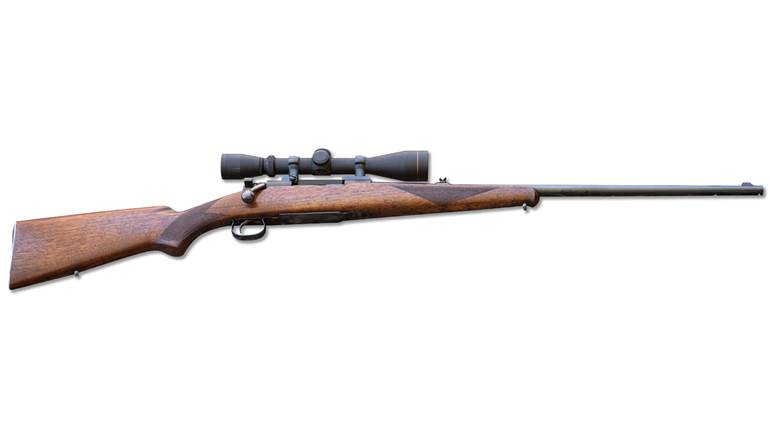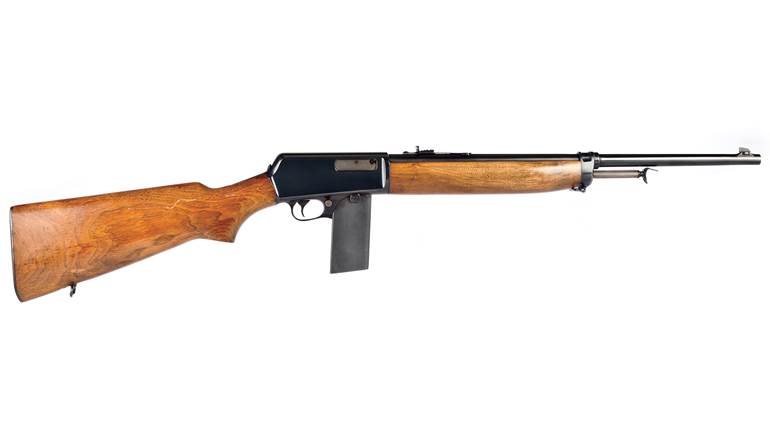
The American firearms market seems to always be either in full-out 24/7 production or in some form of recovery and manufacturing reorganization. During World War I, civilian arms production came to a screeching halt, as manufacturing for the war effort quickly became paramount. The Great War lasted from 1914 to 1918, but U.S. involvement didn’t take place until April 6, 1917. Nonetheless, Winchester contributed heavily to the effort making Pattern 1914 Enfield rifles chambered in .303 British for Britain and 1917 Enfield rifles chambered in .30-06 for the U.S., after it became involved in the war. Thomas Crosley (T.C.) Johnson headed up the production of the bolt-action rifles, which were a new concept to a company built upon lever- and slide-action firearms.
After the war, the brass at Winchester did some reorganization of its product line. Returning Doughboys clearly showed a preference for bolt-action rifles. The Model 1885 Single Shot was discontinued, leaving a blank space in the smallbore target-rifle market. Not wanting to surrender any market share, T.C. Johnson and another designer, Frank Burton, were tasked with developing a superior bolt-action, smallbore target rifle beginning in February 1918. Johnson had already designed several prototype military bolt actions, and he adapted one called the Model D to the rimfire platform. To that scaled-down action, he modified the Model 1885 target barrel to fit the newer action. A stock was made that was a melding of the Model 1895 Winchester-Lee and the fore-end design from the Model 1885 Target based on a custom stock of the Single Shot target designed in 1908 by Winchester’s house marksman, Capt. Albert F. Laudensack. The prototype rifle was given the designation “Experimental Design No. 111.” Johnson and Burton retired to their shops, and each built another prototype with their own interpretations of the parent design.
Thus far, Experimental Design No. 111 was a single-shot, but in the fall of 1918 a design change order stipulated that the rifle have a five-round detachable magazine, sending both Johnson and Burton back to their drawing boards in order to modify the bolt to pick up a cartridge from the magazine. Once that design changed was addressed, a prototype was sent to Lt. Col. Townsend Whelen of the Director of Civilian Marksmanship and Maj. Richard LaGarde and Gen. Fred Phillips of the National Rifle Association. At Whelen’s request, five pre-production samples were sent to the Dewar Cup Team at the National Matches in August 1919. That team won the smallbore title, and a month after the matches Winchester authorized full production of the Model 52.
The Model 52 features a non-rotating bolt that locks with a pair of lugs mounted on a rotating collar toward the rear of the bolt. Its face is counter bored to totally enclose the cartridge head. A pair of opposed extractors and a blade-type ejector take care of extraction and ejection. The heavy receiver, bored and machined from a forging, contained the bolt, fire-control assembly and served as a base for target sights and later optical sights. A heavy contour barrel is 28" long. Remember, the original concept for the Model 52 was as a target and training rifle for the military. The sporter version did not appear until 1934. Johnson’s original trigger design was a two-stage military type, with a horizontal sear that pivots from the front. The trigger passes vertically through a pinned mortise in the sear and cams against the bottom of the bolt, depressing the assembly to release the firing pin. A button release on the right-hand side of the stock holds the magazine in place. In addition to the five-round magazine, a single-shot block (1935) and a 10-rounder were also available. The safety was a wing originally mounted on the left side of the receiver and when engaged blocked the cocking-piece, camming it slightly rearward, thus disengaging the trigger linkage. In 1932, it was moved to the right side of the receiver.
Some early production rifles were chambered for .22 Short, but after 1922 this chambering was discontinued. These samples are exceedingly rare and command a stratospheric premium among Winchester collectors. Initially, the Model 52 was priced at $42.35 for a standard model. This was a substantial amount for a rimfire at the time. Extra-heavy barrels tacked on $25 to that price; nickel-steel added $11, and stainless—which came much later—lightened the buyer’s wallet another $17. The reason for these then-exorbitant prices was the handwork that went into each rifle. Model 52s were given lavish hand fitting and tuning, and this was a significant reason that they were consistently winners in competition, as well as being a premium, high-end rifle.
The Model 52 underwent almost constant changes, many of which were custom orders from target shooters. Sights, stocks and accessories were available, too numerous for us to describe here. One of the more significant changes was the Speed Lock. Burton developed the Speed Lock starting in 1930. It reduced firing pin travel by some 75 percent, thus reducing lock time and increasing inherent accuracy. Speed Lock M52s eliminated the knurled knob at the rear of the bolt (a la 1903 Springfield) with a short boss. The Speed Lock modification did not touch the receiver, and for a time Winchester offered to retrofit the older-style bolt with a Speed Lock. A Model 52A was introduced in 1935 and consisted of a shorter stem on the wing safety to lessen its tendency to bend.
In 1931, a friend of John Olin, the president of Winchester, had a gunsmith remodel his Model 52 into a lightweight sporting model. Olin was impressed with the rifle and ordered development of a factory sporting model. The Model 52 Sporter was introduced in 1934 during the depths of the Depression. It featured a lightweight 24” barrel with a high-gloss finish on a stock of figured walnut with a slender, tapered fore-end with a contrasting tip. The stock has a pistol grip, with a high comb and cheekpiece, along with fine checkering. An M52’s receiver was identical with the target models, except that the top was left round rather than milled flat. At a mere 7.25 lbs., the 52 Sporter was equipped with a Lyman 48-F aperture sight standard with an integral forged front sight base with a brass bead and retailed for $88.50, or about $1,800 in today’s dollars. Consequently, it is a relatively rare model. Because of the desirability of the Model 52 Sporter, fakes are numerous. A genuine Sporter commands about twice what a comparable condition target model will today.
The Model 52 had a pretty good run, from 1920 until 1980. Some 125,233 copies were made, which may seem light, but recall that this was a high-end premium rifle. Along with the Model 70, these rifles cemented into the shooting public’s eye the superiority of the Winchester brand for a couple of generations. In the early 1990s, FN Herstal—who owned the Winchester name—reintroduced a Miroku-made copy of the Model 52 under the Browning brand. Although not a bad rifle, it could not compare to the early 20th-century craftsmanship of the originals.
Gun geeks—like me—often mourn the passing of such beautifully made firearms like the Model 52, often dubbed “The king of .22s.” The unfortunate truth is that by their very nature, they are rare because of the amount of human care that goes into their making. Only a few can afford such luxury, and fewer still can truly appreciate the advantages such guns have in the using.





































